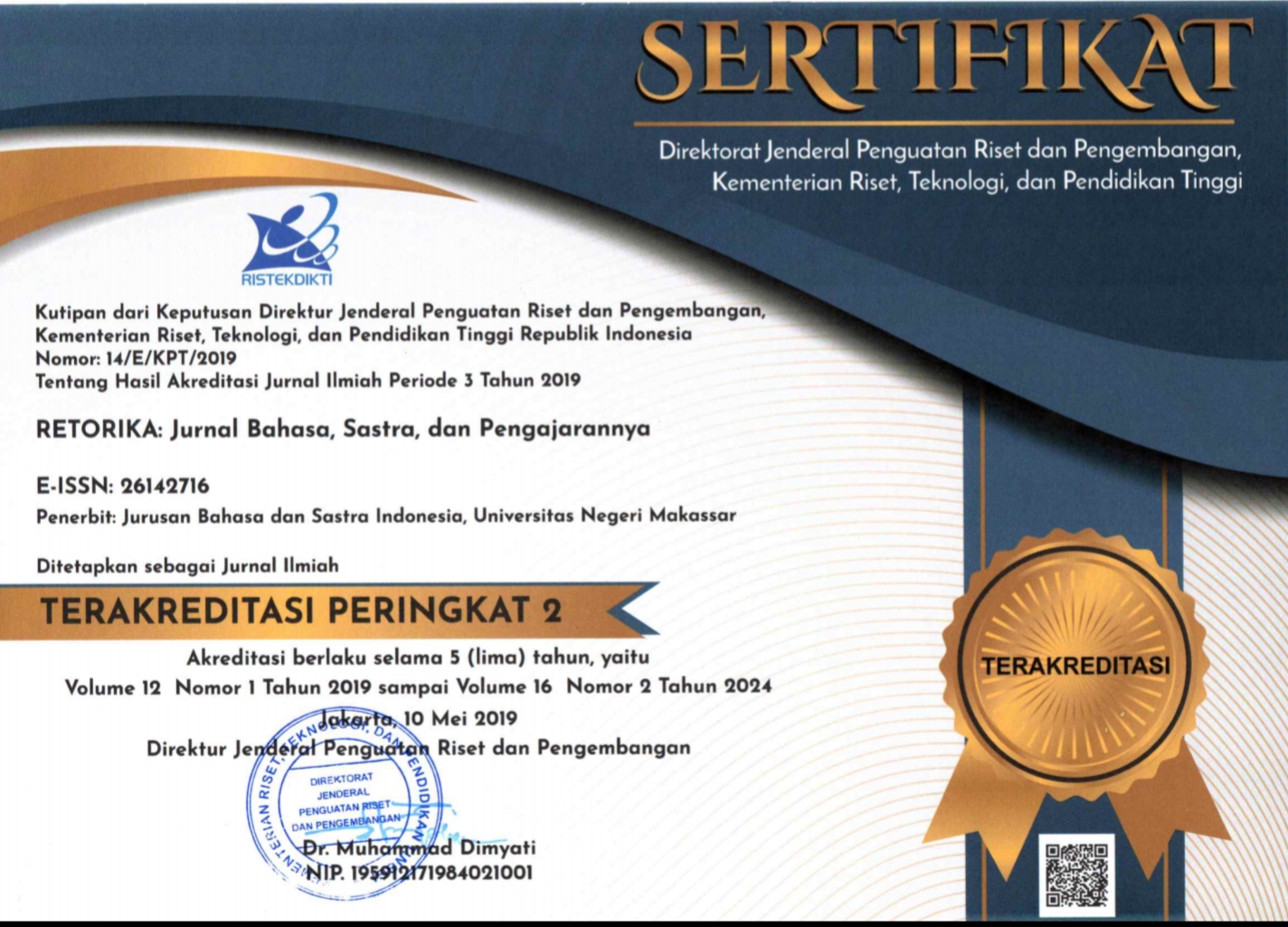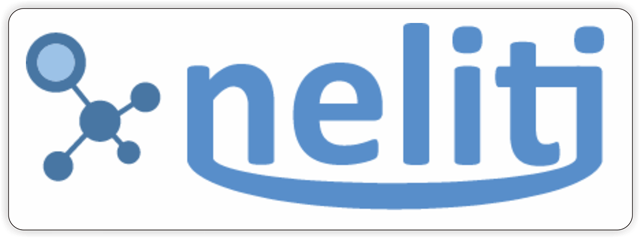COVID-19 ADVERTISING LANGUAGE LOCUTIONARY, ILLOCUTIONARY AND PERLOCUTIONARY FORMS ON SOCIAL MEDIA (A SOCIOPRAGMATIC STUDY)
(1) Universitas Muhammadiyah Makassar
(2) Universitas Muhammadiyah Makassar
(3) Fakultas Bahasa dan Sastra, Universitas Negeri Makassar
(4) Universitas Muhammadiyah Makassar
(*) Corresponding Author
DOI: https://doi.org/10.26858/retorika.v16i2.32531
Abstract
This study seeks to conduct an analysis of locutions, illocutions, and perlocutions within the context of the utilization of the Indonesian language in public service advertisements pertaining to the subject of Covid-19. The research conducted is classified as a qualitative descriptive study. Data for this research endeavor were collected in May 2021 through meticulous note-taking and documentation techniques. Subsequent data analysis ensued through a structured sequence of procedures, which encompassed: identification, classification, analysis, interpretation, and description, with the latter aimed at providing a comprehensive overview of the outcomes of the data analysis. The focal point of this inquiry is the realm of Public Service Advertisements that revolve around the theme of Covid-19. Our scrutiny primarily pertains to an examination of the locutionary, illocutionary, and perlocutionary dimensions of these advertisements. Upon the thorough examination of the ten public service advertisements included in this study, spanning various mediums such as television, billboards, and social media, it was discerned that all of them shared a common objective. The locutionary aspect, serving as the foundational semantic content, predominantly conveys basic information concerning the transmission of Covid-19. In parallel, the illocutionary facet of these messages serves as a cautionary directive, imparting a sense of urgency and imparting an effect stemming from the act of speech. Furthermore, the perlocutionary dimension of these messages, specifically regarding Covid-19, invokes a call to action. This entails the necessity of disrupting the transmission chain of the Covid-19 virus while simultaneously bolstering one's immune system, rigorously implementing health protocols, and adopting measures to flatten the curve of Covid-19 transmission.
Keywords
Full Text:
PDFReferences
Adityo, S., & Etc. (2020). Coronavirus Disease 2019: Recent Literature Review. Indonesian Journal of Internal Medicine .
Alex, S. (2019). Media Text Analysis. Bandung: Rosdakarya Youth.
Amalia, N. (2021). Illocutionary Act of Dissociative Identity Disorder in the Main Character of The Split Movie. Alphabet, 4(1), 31-38.
Aminuddin. (2011). Semantics Introduction to the Study of Meaning. Bandung: Sinar Baru Algesindo.
Arthur, A., & Berger. (2010). Introduction to Semiotics . Yogyakarta: Tiara Wacana.
Astri, ND (2020). Analysis of Locutionary, Illocutionary, and Perlocutionary Speech Acts in Tweets or Memes on Instagram Social Media. Prima Indonesian Journal (BIP) , 2 (2), 20–30. https://doi.org/10.34012/bip.v2i2.1187.
Bogdan, R., & Biklen, S. K. (2014). Qualitative research for education. Boston, MA: Allyn & Bacon.
Chong, S., Ali, S., Ðoàn, L., Yi, S., Trinh-Shevrin, C., & Kwon, S. (2022). Social Media Use and Misinformation Among Asian Americans During Covid-19. Frontiers in Public Health, 9. https://doi.org/10.3389/fpubh.2021.764681.
Dani, A. J., & Aryo Bayu, W. (2013). Public Service Advertisement about Cyberbullying to Foster Community Awareness. Createvitas: Jurnal Ilmiah Desain Komunikasi Visual, 2(1).
Islam, S., Sarkar, T., Khan, S., Kamal, A., Hasan, S., Kabir, A., … & Seale, H. (2020). Covid-19–Related Infodemic and Its Impact on Public Health: A Global Social Media Analysis. The American Journal of Tropical Medicine and Hygiene, 103(4), 1621-1629. https://doi.org/10.4269/ajtmh.20-0812.
Kridalaksana, H. (2011). Linguistic Dictionary (Fourth). Jakarta: PT Ikrarr Mandiri Abadi.
Kriyanto, & Rachmat. (2013). Advertising Management . Malang: UB Press.
Li, X. & Liu, Q. (2020). Social Media Use, Ehealth Literacy, Disease Knowledge, and Preventive Behaviors in the Covid-19 Pandemic: Cross-Sectional Study on Chinese Netizens. Journal of Medical Internet Research, 22(10), e19684. https://doi.org/10.2196/19684.
Masrul, & Etc. (2020). The Covid-19 Pandemic: Problems and Reflections in Indonesia. Our Foundation for Writing.
Nugroho, A. S. (2012). Critical Discourse Analysis of Tax Advertisements in the Formation of Reality in Public Life.. Ranah: Jurnal Kajian Bahasa, 1(1), 56-70
Nurfebiaraning, & Sylvie. (2017). Advertising Management . Yogyakarta: Depublish.
Santoso, D. H. (2018). Media and Political Communication (Portrait of Democracy in Indonesia from a Political Communication Perspective). MBridge Press, Yogyakarta. ISBN 978-602-52470-7-1.
Siyoto, Sandu, & Sodik, A. (2015). Basic Research Methodology . Yogyakarta: Suakamedia.
Situmorang, J. R. (2008). Why Advertising ?. Jurnal Administrasi Bisnis, 4(2).
Stevani, M., Tarigan, K., Sawalmeh, M., & Ginting, F. (2023). A Case Study of Locutionary, Illocutionary, and Perlocutionary Speech Acts in English Learning Interactions in Junior High School. Journal of World Englishes and Educational Practices, 5(1), 47-56. https://doi.org/10.32996/jweep.2022.5.1.5.
Suardana, I. (2020). Speech Acts Found in the Novel “Snowing In Bali”. International Journal of Linguistics Literature and Culture, 7(1), 23-31. https://doi.org/10.21744/ijllc.v7n1.1106 .
Sultan, S., Rapi, M., Haris, H., & Saleh, M. (2023). Speech Acts in Appeals For Social Distancing And Public Compliance Intentions During the Covid-19 Pandemic In Indonesia. Indonesian Journal of Applied Linguistics, 12(3), 815-830. https://doi.org/10.17509/ijal.v12i3.50574.
Tanjung, F. (2019). Speech Acts Categories: An Analysis Of Characters’ Utterances in “Beauty and The Beast”. Tell-Us Journal, 5(1), 41-54. https://doi.org/10.22202/tus.2019.v5i1.3229.
Article Metrics
Abstract view : 171 times | PDF view : 92 timesRefbacks
- There are currently no refbacks.
Copyright (c) 2023 Abdul Rahman Rahim

This work is licensed under a Creative Commons Attribution-NonCommercial 4.0 International License.
Published by:
Department of Indonesian Language, Faculty of Languages and Literature, Universitas Negeri Makassar in cooperate with Asosiasi Dosen Bahasa dan Sastra Indonesia (ADOBSI) and Ikatan Program Studi Pendidikan Bahasa dan Sastra Indonesia (IKAPROBSI).
Address: Department of Indonesian Language Office, DG Building Second Floor, UNM Parangtambung, Daeng Tata Raya Street, Makassar, South Sulawesi, Indonesia
 Email: retorika@unm.ac.id
Email: retorika@unm.ac.id

RETORIKA: Jurnal Bahasa, Sastra,dan Pengajarannya is licensed under a Creative Commons Attribution-NonCommercial 4.0 International License.
















